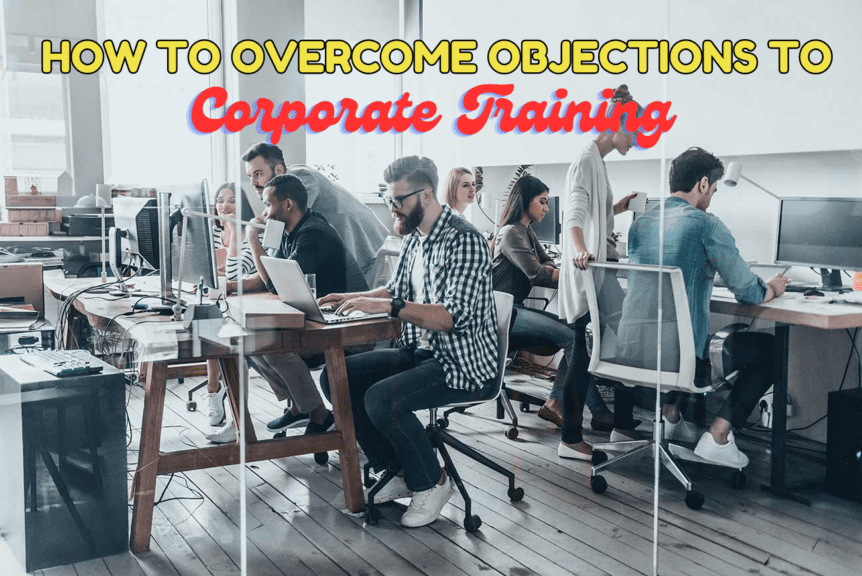How to Overcome Objections to Corporate Training
Objections and resistance to training can occur for a variety of reasons, not least the fact that people are generally very busy so see training as an added burden. One answer to objections and resistance is to simply force employees to complete the training. However, this approach will limit the impact of the training and the results you want to achieve. The better way to deal with resistance to training is to address the objections.
By addressing and dealing with the objections in the most effective way possible, you can increase engagement with the training course in question as well as your wider training strategy.
The following steps and strategies will help you overcome objections to corporate training.
Understand the Objections
A good starting point is to make sure you understand the objections. There can be a tendency to put objections down to a resistance to change. However, if you dig deeper, you might find there are other concerns that are causing the objections.
When working to understand why employees are resistant to the training you want them to complete, it helps to identify whether the objections are based on past experiences, misconceptions, or genuine concerns. Understanding this will guide the next steps in the process. For example, if the objections are based on misconceptions, you can clarify the situation.
Show the Value
An important part of overcoming objections is to demonstrate the value of the training to the learner. For example:
- Quantify the potential return on investment and show how the training can lead to increased productivity, fewer mistakes, or better customer relations.
- Share success stories and case studies from other organisations or departments that benefited from similar training.
- Illustrate the costs of not completing the training. Those costs could be higher than necessary error rates, lower sales, increased compliance risks, or lost commercial opportunities.
Make the Training Relevant
Employees will be more resistant to training if they struggle to understand its relevance to them personally and their responsibilities. Therefore, make sure you tailor the training you create to the experiences of employees and the challenges they face. Using real-world examples and case studies can help.
Address Logistical Concerns
The objections that employees have to training can be down to time, work pressures, and availability. As a result, it is important to mitigate these concerns as much as possible.
One of the best ways of doing this is by offering the training in a flexible format, such as e-learning. Providing employees with e-learning courses means they can complete the training at a time that best suits their schedule.
If all or part of the training has to be completed in person, schedule the sessions at the most convenient possible time.
Pilot the Training
Piloting new training courses with a small group of learners helps in a range of areas, including identifying problems with content or technical issues. Setting up pilot training can also help you overcome objections as you can get feedback and make any necessary adjustments. You can then use the positive experiences of the pilot group as testimonials to encourage others to get on board with the training programme.
Engage Influencers
Influencers exist in every group, team, department, and organisation. Getting them on board with the training is not a guarantee of success, but it can help, particularly if those with influence advocate for the training. At the very least, you can avoid situations where influencers act negatively.
It is also often beneficial to get buy-in from respected figures in the organisation and to encourage managers and team leaders to promote the benefits and value of the training.
Demonstrate Past Success
Where available, you should share information on past training programmes to show how they have improved performance, reduced risks, or achieved other positive outcomes. Testimonials from learners on other training courses can also help.
Maximise Personalisation and Flexibility
Personalisation and flexibility are two of the most powerful ways to overcome objections to training. For example, allowing employees to choose modules or skip through sections where they are already strong rather than having to go through all the elements.
Involve Employees in the Process
You are less likely to meet resistance to training if employees have been involved in the process. You can involve employees in the development of new training courses by asking for their feedback and allowing them to provide input where it makes sense to do so.
Continuous Follow-Up
The work you do after employees complete the training is as important as the work you do beforehand. This includes asking for feedback and assessing the performance of individual employees. Providing refresher courses can also help reinforce the importance of the training.
It can also help with your long-term training strategy to provide information to employees that shows the benefits of training and connects individual training courses to real-world results.
Above All, Make Training Engaging
You will struggle to win the hearts and minds of employees if the training is boring and uninteresting. Therefore, it’s important to make the training as engaging as possible. Some tips for making training engaging include:
- Use e-learning as the training delivery method.
- Include interactive features such as simulations, gamified elements, or real-world exercises.
- Use a variety of media, including videos and relevant images.
Continuous Learning
By following the tips and strategies above, you can not only address objections to individual training courses, but also help to develop a continuous learning culture in your organisation. As organisations with a continuous learning culture experience less resistance to training, this is a beneficial outcome to work towards.
